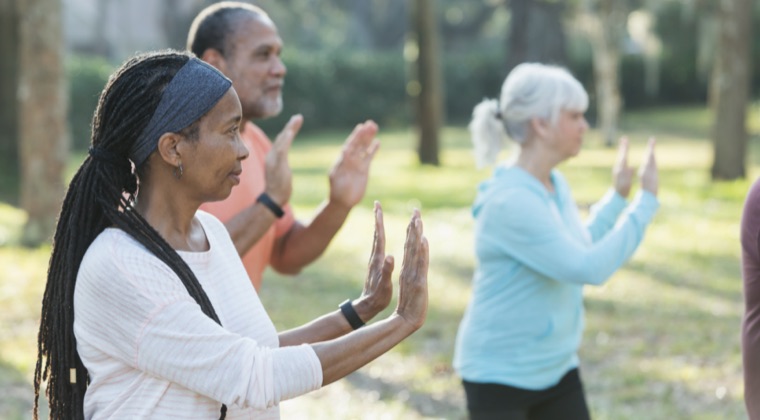Yoga
What is yoga?
Yoga is an ancient set of practices that originated in India. These practices include a rich philosophical tradition, an ethical and moral framework, physical postures (called asanas), breathing techniques (pranayama), and meditation. There are many different yoga traditions and schools which draw on various aspects of these practices. For example, many yoga teachers in the United States focus solely on breath and postures. Yoga is often taught in individual or group classes.
How does yoga work?
While yoga has been practiced for thousands of years, Western scientists only started doing yoga studies over the past several decades. Yoga has been employed historically to treat numerous medical conditions, and recent studies have shown that yoga can be a useful chronic pain management strategy by reducing stress and anxiety, decreasing pain, and enhancing strength and flexibility. The ways in which yoga works likely depend on which yogic practices are employed, as there is much overlap between the benefits of yoga practices and other mind-body techniques (e.g. meditation).
Yoga postures can help strengthen or stretch parts of the body that are weak or stiff, as well as enhancing bodily awareness and pain tolerance. Breathing practices can improve lung function, increase relaxation, and help practitioners improve emotional regulation. Meditative practices can enhance focus, concentration, and mental/emotional clarity, while also supporting bodily, mental, and emotional awareness. Taken together, these practices can help practitioners identify behaviors and thoughts that contribute to worsened pain, as well as teaching movements and skills to help accept or lessen pain.
Unfortunately, because of the lack of standardization in teaching, unreliable insurance coverage, and the relatively new state of the medical literature, the burden of finding the right yoga teacher and practice(s) fall upon the individual practitioner.
What are some common yoga styles?
Hatha: Generic term referring to yoga classes that include physical postures. Typically involves slower movement and holding poses for longer.
Vinyasa: More dynamic movement, links breath to movement, variable sequencing, lively music.
Ashtanga: Very physically rigorous, links breath to movement, same order of sequences in every class.
Restorative: Gentle movements, lots of supports (e.g., blocks, blankets), long holds in each posture.
Hot yoga: Same order of sequences in every class, artificially heated classrooms that are 95º Fahrenheit or warmer.
Who can be a yoga provider?
In the US, yoga is typically taught by certified yoga teachers. These teachers may have variable degrees of training (200, 500, or 1000 hours) as well as specialty certifications, such as prenatal, children's, or trauma-sensitive yoga. There are many yoga and teaching styles, so it is worth searching for a teacher whose style aligns with your specific needs or preferences.
While not always appropriate for someone who is completely new to yoga, there are numerous free online yoga videos that are available (see Resources).
Note: Most yoga classes are not covered by insurance. This may differ depending on where you live.
What to expect
As there are many different schools of yoga and yoga styles, what to expect will vary in each class. Most classes are 60 to 75 minutes long, have multiple participants (5–20), and are mat-based. Classes typically cost $10–$30. An example of a typical one-hour class is as follows:
- Centering (5–10 minutes): Using breathing exercises or a gentle warm up to try to become more present in the space and the body. This is also the time during which the intention for the class is set.
- Movement (40–50 minutes): The sequence of postures will vary depending on which part(s) of the body are being targeted and the relative physical rigor of the class.
- Rest and relaxation (5–10 minutes): Lying down, resting, and/or meditation.
Depending on the yoga teacher and style of yoga, the class may also involve chanting, longer periods of meditation or breathing exercises, and checking-in with the teacher before or after class. If you are unsure of or are uncomfortable with certain practices, it is important to check-in with the teacher or studio owner to ensure that you choose a class in alignment with your needs.
It is also possible to schedule private yoga lessons, which often cost $50–$120 per hour. These lessons involve more personalized instruction and may represent a useful way to build the foundation of a yoga practice if you are unfamiliar with yoga and/or are uncomfortable participating in a large class.
Potential Risks
Yoga is generally considered quite safe. As with other forms of exercise, it is possible to overexert oneself, fall down, or endure other injuries. It is important to pay attention to the body to ensure that the movements align with individual needs. Consider starting with low impact, gentle classes and gradually increasing intensity if desired.
Resources
You can find a school or yoga teacher registered through the Yoga Alliance.
You can practice yoga with free online videos. One such resource is Yoga with Adriene.
You can also practice yoga through subscription sites, such as Jamie Elmer's.


